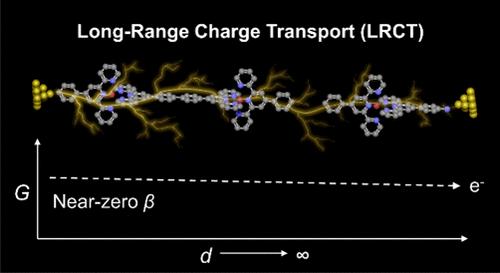当前位置:
X-MOL 学术
›
J. Am. Chem. Soc.
›
论文详情
Our official English website, www.x-mol.net, welcomes your
feedback! (Note: you will need to create a separate account there.)
Long-Range Charge Transport in Molecular Wires
Journal of the American Chemical Society ( IF 14.4 ) Pub Date : 2024-11-14 , DOI: 10.1021/jacs.4c11431 Jiung Jang, Hyo Jae Yoon
Journal of the American Chemical Society ( IF 14.4 ) Pub Date : 2024-11-14 , DOI: 10.1021/jacs.4c11431 Jiung Jang, Hyo Jae Yoon

|
Long-range charge transport (LRCT) in molecular wires is crucial for the advancement of molecular electronics but remains insufficiently understood due to complex transport mechanisms and their dependencies on molecular structure. While short-range charge transport is typically dominated by off-resonant tunneling, which decays exponentially with molecular length, recent studies have highlighted certain molecular structures that facilitate LRCT with minimal attenuation over several nanometers. This Perspective reviews the latest progress in understanding LRCT, focusing on chemical designs and mechanisms that enable this phenomenon. Key strategies include π-conjugation, redox-active centers, and stabilization of radical intermediates, which support LRCT through mechanisms such as coherent resonant tunneling or incoherent hopping. We discuss how the effects of molecular structure, length, and temperature influence charge transport, and highlight emerging techniques like the Seebeck effect for distinguishing between transport mechanisms. By clarifying the principles behind LRCT and outlining future challenges, this work aims to guide the design of molecular systems capable of sustaining efficient long-distance charge transport, thereby paving the way for practical applications in molecular electronics and beyond.
中文翻译:

分子线中的长距离电荷传输
分子线中的长距离电荷传输 (LRCT) 对于分子电子学的发展至关重要,但由于复杂的传输机制及其对分子结构的依赖性,人们仍未得到充分的理解。虽然短距离电荷传输通常以非谐振隧穿为主,它随分子长度呈指数衰减,但最近的研究强调了某些分子结构,这些结构有助于 LRCT 在几纳米范围内以最小的衰减。本观点回顾了理解 LRCT 的最新进展,重点关注促成这一现象的化学设计和机制。关键策略包括 π 偶联、氧化还原活性中心和自由基中间体的稳定化,它们通过相干共振隧穿或不相干跳跃等机制支持 LRCT。我们讨论了分子结构、长度和温度的影响如何影响电荷传输,并重点介绍了用于区分传输机制的新兴技术,如塞贝克效应。通过阐明 LRCT 背后的原理并概述未来的挑战,这项工作旨在指导能够维持高效长距离电荷传输的分子系统的设计,从而为分子电子学及其他领域的实际应用铺平道路。
更新日期:2024-11-14
中文翻译:

分子线中的长距离电荷传输
分子线中的长距离电荷传输 (LRCT) 对于分子电子学的发展至关重要,但由于复杂的传输机制及其对分子结构的依赖性,人们仍未得到充分的理解。虽然短距离电荷传输通常以非谐振隧穿为主,它随分子长度呈指数衰减,但最近的研究强调了某些分子结构,这些结构有助于 LRCT 在几纳米范围内以最小的衰减。本观点回顾了理解 LRCT 的最新进展,重点关注促成这一现象的化学设计和机制。关键策略包括 π 偶联、氧化还原活性中心和自由基中间体的稳定化,它们通过相干共振隧穿或不相干跳跃等机制支持 LRCT。我们讨论了分子结构、长度和温度的影响如何影响电荷传输,并重点介绍了用于区分传输机制的新兴技术,如塞贝克效应。通过阐明 LRCT 背后的原理并概述未来的挑战,这项工作旨在指导能够维持高效长距离电荷传输的分子系统的设计,从而为分子电子学及其他领域的实际应用铺平道路。


















































 京公网安备 11010802027423号
京公网安备 11010802027423号